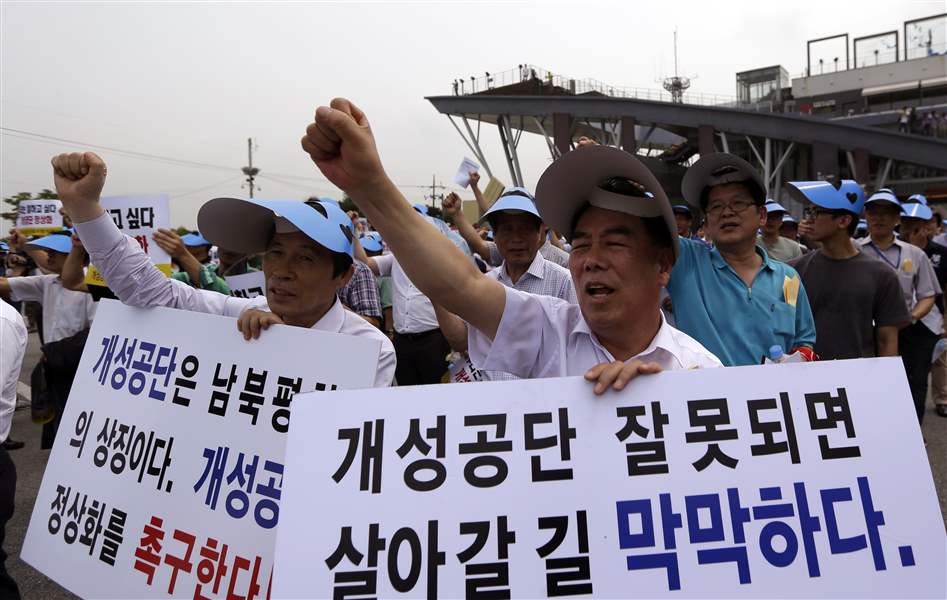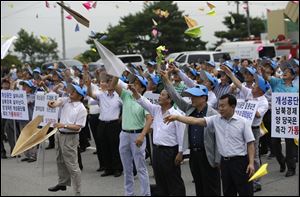
N. Korea lifts ban on joint factory park operations
8/7/2013
South Korean owners who run factories in the stalled South Korea and North Korea's joint Kaesong industrial complex and workers shout slogans during a rally insisting the normalize the operation of the industrial complex at the Imjingak Pavilion near the border village of Panmunjom, which has separated the two Koreas since the Korean War, in Paju, north of Seoul, South Korea, Wednesday, Aug. 7, 2013. About 500 owners and workers gathered near the border area for the rally. The letter read "Kaesong industrial complex is the symbol of two Koreas." (AP Photo/Lee Jin-man)
ASSOCIATED PRESS

South Korean owners who run factories in the stalled South Korea and North Korea's joint Kaesong Industrial Complex and workers throw paper airplanes during a rally at the Imjingak Pavilion near the border village of Panmunjom today.
SEOUL, South Korea — North Korea said today it is lifting a ban on operations at a jointly run factory park shuttered since Pyongyang pulled out its 53,000 workers in April amid tensions with South Korea, and the rivals agreed to meet next week for talks meant to restart the complex.
The agreement revives hope for the resumption of production at the Kaesong complex, the last remaining symbol of inter-Korean cooperation from an earlier period of detente. The industrial park combined South Korean initiative, capital and technology with cheap North Korean labor. It was also a rare source of hard currency for North Korea, though the economically depressed country chafed at suggestions that it needed the money Kaesong generated.
North Korea said it will lift its ban on operations at the complex, including restrictions on the entry of South Korean managers. But the two countries must reach a formal accord on their differences before production can resume, and six past meetings on the park’s fate remained deadlocked.
The statement by the North’s Committee for the Peaceful Reunification of Korea, which is responsible for dealings with Seoul, appeared to accept a demand that South Korean negotiators had made in the deadlocked sessions: That North Korea won’t unilaterally close the industrial complex, just north of the heavily armed border, should tensions between the rivals rise again.
Ahead of today's statement, which North Korea described as “bold and magnanimous,” there was unease in Seoul about the fate of Kaesong. The statement came after 10 days of silence from Pyongyang on a South Korean demand for “final talks.” It also came about an hour after Seoul said it would begin insurance payments to 109 South Korean businesses shut out of Kaesong, which some saw as a step toward closing the park.
South Korea’s Unification Ministry, which handles relations with North Korea, accepted the North’s proposal for talks on Aug. 14, a day before a holiday in both Koreas that celebrates independence from Japan’s 1910-1945 colonial rule. Seoul expressed hope the meeting would resolve differences on Kaesong.
South Korean businesses with operations at Kaesong welcomed the development. The park had survived previous periods of tension between the rivals, including attacks blamed on Pyongyang that killed 50 South Koreans in 2010, and the shutdown of other big cooperation projects
North Korea banned South Korean managers from crossing the border to their jobs in Kaesong and then withdrew its workers from the park during a torrent of warlike threats it made in March and April, including vows of nuclear strikes on Washington and Seoul. Pyongyang said it was angry over annual U.S.-South Korean military drills and U.N. sanctions over North Korea’s February nuclear test — the country’s third such test since 2006.
There have been recent attempts at tentative diplomacy by the Koreas, but tensions could rise again this month as South Korea and the United States are scheduled to begin a joint military exercise on Aug. 19.
Starting Thursday, South Korean companies that had signed up for insurance were to receive payments to help cover investments in constructing production lines and buildings at Kaesong.
Both countries should ensure that operations at the complex continue normally regardless of external matters, the North’s statement said. North Korea also said it will guarantee the safety of the South Korean managers and property at Kaesong, and start sending North Korean workers to the park once South Korean businesses are ready to resume operations.
After breaking ground in 2003, earlier South Korean governments paved roads and erected buildings at Kaesong, which lies in a guarded, gated complex on the outskirts of North Korea’s third-largest city. By the end of 2012, South Korean companies had produced a total $2 billion worth of goods during the previous eight years.
Pyongyang needs to reach out to Seoul and resume operations at Kaesong to resolve its huge economic problems, said Yoo Ho-yeol, a North Korea studies professor at Korea University in Seoul.
North Korea is estimated to have received $80 million in workers’ salaries in 2012, an average of $127 a month per person, paid in U.S. dollars, according to the Unification Ministry.
For South Korea, Asia’s fourth-largest economy, the complex was more than a business opportunity and a source of cheap labor — it was a symbol representing the possibility of eventual unification. Before April, the Kaesong industrial complex was the only place for South Korean entrepreneurs to collaborate with North Korean workers.